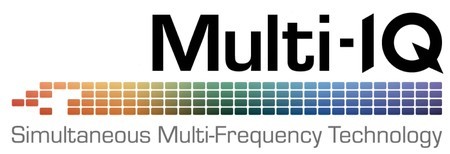
When Minelab started developing our EQUINOX detector, we looked very closely at all of the current market offerings (including our own) to reassess what detectorists were really after in a new coin & treasure detector. A clear short list of desirable features quickly emerged – and no real surprises here – waterproof, lightweight, low-cost, wireless audio, and of course, improved performance from new technology. This came from not only our own observations, but also customers, field testers, dealers and the metal detecting forums that many detectorists contribute to.
While we could have taken the approach of putting the X-TERRA (VFLEX technology) in a waterproof housing and adding a selectable frequency range, this would have been following the path of many of our competitors in just rehashing an older single frequency technology that had already reached its performance limits. Another option would have been to create a lower cost waterproof FBS detector, but that also had its challenges with FBS being ‘power hungry’, needing heavier batteries, heavier coils, etc., and relatively high cost compared to the more recent advances that our R&D team have been making with the latest electronics hardware and signal processing techniques.
When Minelab develop a new detecting technology we aim to create a paradigm shift from existing products and provide a clear performance advantage for our customers.
Our Technology History
The multi-frequency broad band spectrum (BBS) technology that first appeared in Sovereign detectors in the early 1990’s provided an advantage over single frequency coin & treasure detectors. This evolved into FBS with Explorer, all the way through to the current CTX 3030 (FBS 2).
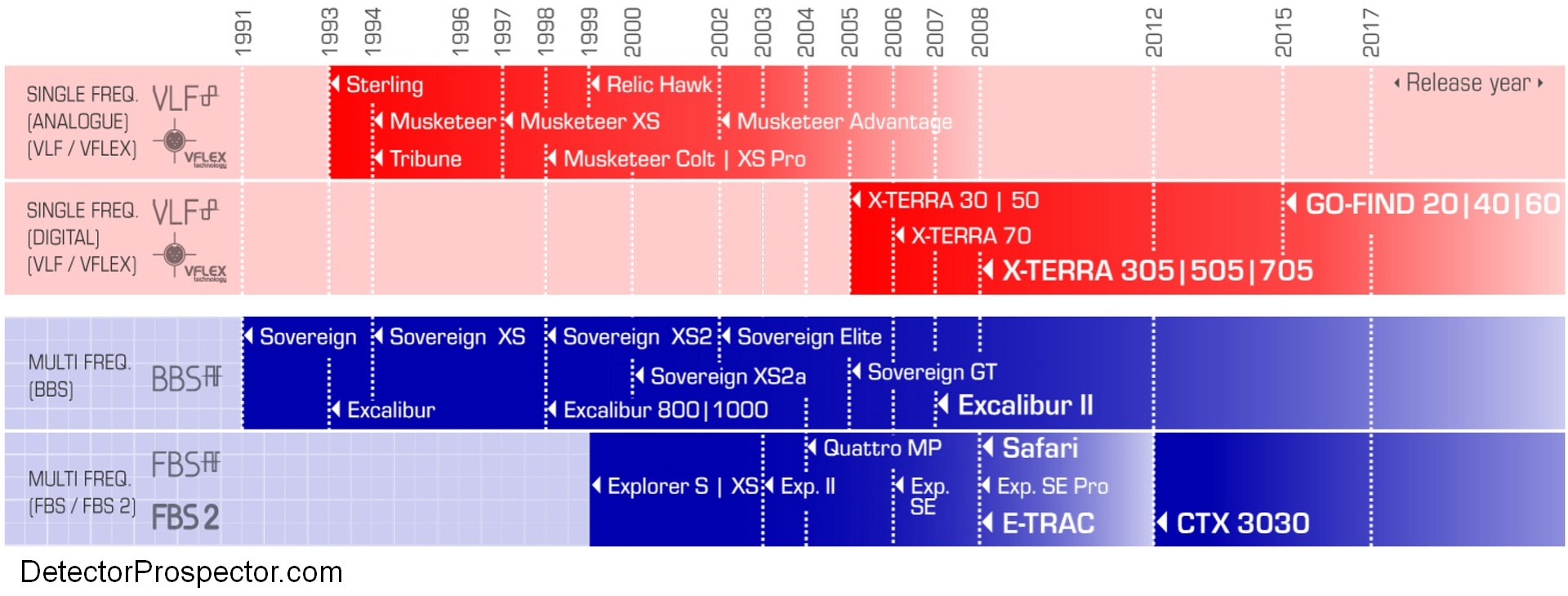
The multi-period sensing (MPS) PI technology that first appeared in the SD 2000 detector in the mid 1990’s gave a significant advantage over single frequency gold detectors. This key technology exists in the current GPX Series detectors today.
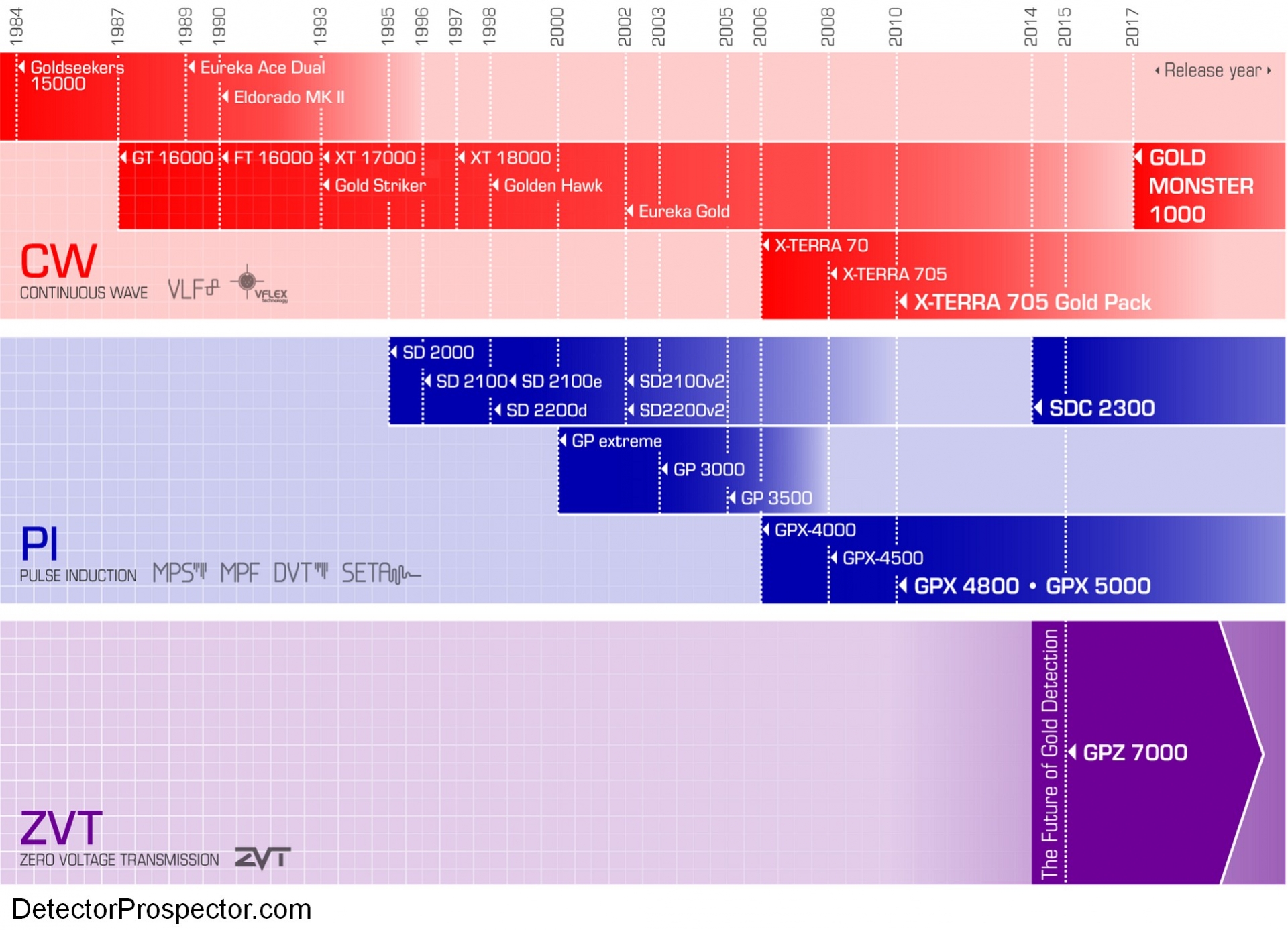
Zero Voltage Transmission (ZVT) is our latest gold detection technology implemented in the GPZ 7000 and is a recent example of Minelab’s continued innovation beyond ‘tried and true’ technologies to achieve improved performance.
Further to our own consumer products, our R&D team also has significant experience working with the US and Australian military on multi-frequency technologies for metal detection.
Introducing Multi-IQ
Multi-IQ is Minelab’s next major innovation and can be considered as combining the performance advantages of both FBS and VFLEX in a new fusion of technologies. It isn’t just a rework of single frequency VLF, nor is it merely another name for an iteration of BBS/FBS. By developing a new technology, as well as a new detector ‘from scratch’, we will be providing both multi-frequency and selectable single frequencies in a lightweight platform, at a low cost, with a significantly faster recovery speed that is comparable to or better than competing products.

We have come out with a very bold statement that has captured a lot of market attention:
“EQUINOX obsoletes all single frequency VLF detectors”
Multi-IQ achieves a high level of target ID accuracy at depth much better than any single frequency detector can achieve, including switchable single frequency detectors that claim to be multi-frequency. When Minelab use the term “multi-frequency” we mean “simultaneous” – i.e. more than one frequency is transmitted, received AND processed concurrently. This enables maximum target sensitivity across all target types and sizes, while minimizing ground noise (especially in saltwater). There are presently only a handful of detectors from Minelab and other manufacturers that can be classed as true multi-frequency, all of which have their own advantages and disadvantages.
How does Multi-IQ compare to BBS/FBS?
Multi-IQ uses a different group of fundamental frequencies than BBS/FBS to generate a wide-band multi-frequency transmission signal that is more sensitive to high frequency targets and slightly less sensitive to low frequency targets. Multi-IQ uses the latest high-speed processors and advanced digital filtering techniques for a much faster recovery speed than BBS/FBS technologies. Multi-IQ copes with saltwater and beach conditions almost as well as BBS/FBS, however BBS/FBS still have an advantage for finding high conductive silver coins in all conditions.
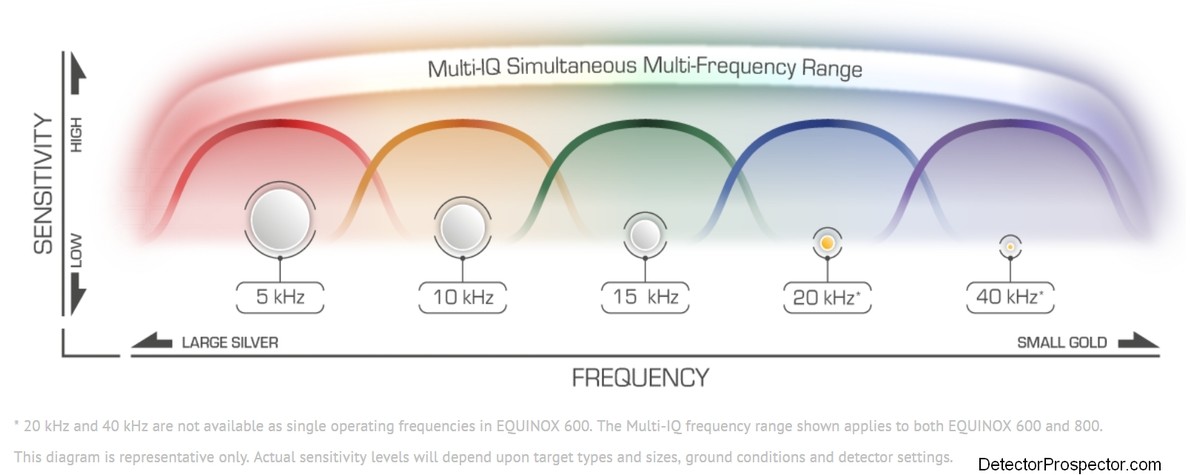
“* 20 kHz and 40 kHz are not available as single operating frequencies in EQUINOX 600. The Multi-IQ frequency range shown applies to both EQUINOX 600 and 800. This diagram is representative only. Actual sensitivity levels will depend upon target types and sizes, ground conditions and detector settings.“
Questions & Answers
What actually is Multi-IQ technology? What does the name stand for? What frequencies does it use? Is “Multi” the same or different for the various Detecting Modes? Is Multi-IQ the same or different for EQUINOX 600 and EQUINOX 800? Why use a single frequency? How does EQUINOX perform in certain environments? How does EQUINOX perform compared to other Minelab detectors? How does EQUINOX perform against other brand detectors?
These are some of the myriad of questions we have seen since we published our EQUINOX Product Notice in mid-September. Some of the answers will have to wait until Minelab publishes reports from our field testers and/or you get your own hands on a detector to try yourself. In the meantime, let’s look further into the aspects of Multi-IQ technology.
Multi-IQ is derived from:
Simultaneous Multi-Frequency In-phase and Quadrature Synchronous Demodulation.
We can go to a statement from Dr Philip Wahrlich, our principal technology physicist, about a key difference of Multi-IQ compared to the demodulation taking place in conventional single frequency VLF detectors:
“Within the Multi-IQ engine, the receiver is both phase-locked and amplitude-normalized to the transmitted magnetic field – rather than the electrical voltage driving the transmitted field. This field can be altered by the mineralization in the soil (in both phase and amplitude), so if the receiver was only phased-locked to the driving voltage, this would result in inaccurate target IDs and a higher audible noise level. Locking the receiver to the actual transmitted field, across all frequencies simultaneously (by measuring the current through the coil) solves these issues, creating a very sensitive AND stable detector”
Precisely measuring these extremely small current variations is quite remarkable if you consider the levels involved. It’s actually parts per billion, or nanoamp signals, we are talking about here!
With Multi-IQ, we can derive much greater target ID accuracy and increased detecting performance, especially in ‘difficult’ ground. In ‘mild’ ground, single frequency may perform adequately, BUT depth and stable ID’s will be limited by ground noise; whereas the Multi-IQ simultaneous multi-frequency will achieve maximum depth with a very stable target signal. In ‘strong’ ground, single frequency will not be able to effectively separate the target signal, giving decreased results; whereas Multi-IQ will still detect at depth, losing a minimal amount of target accuracy. This is how we would generally represent the multi-frequency advantage, based on our engineering test data.
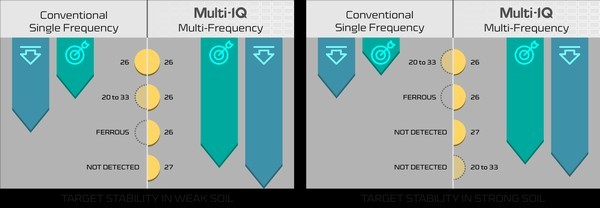
Let’s hear more from Philip Wahrlich about the technical details:
“For each frequency the detector transmits and receives there are two signals which can be extracted which we refer to as I and Q. The Q signal is most sensitive to targets, while the I signal is most sensitive to iron content. Traditional single-frequency metal detectors use the Q signal to detect targets, and then use the ratio of the I and Q signals to assess the characteristics of the target and assign a target ID. The problem with this approach is that the I signal is sensitive to the iron content of the soil. The target ID is always perturbed by the response from the soil, and as the signal from the target gets weaker, this perturbation becomes substantial. With some simplification here for brevity, if a detector transmits and receives on more than one frequency, it can ignore the soil sensitive I signals, and instead look at the multiple Q signals it receives in order to determine a target ID. That way, even for weak targets or highly mineralized soils, the target ID is far less perturbed by the response from the soil. This leads to very precise target IDs, both in mineralized soils and for targets at depth.”
“How many simultaneous frequencies?” you may ask, wondering if this is a critical parameter. Minelab has been carrying out detailed investigations into this in recent years. Just as you can color in a map with many colors, the minimum number to differentiate between adjacent countries is only 4 – a tough problem for mathematicians to prove, over many years. Similar to the map problem, it’s perhaps not the maximum number of frequencies needed to achieve an optimum result, but the minimum number that is more interesting. When it comes to frequencies in a detector, to cover all target types, how the frequencies are combined AND processed is now more important, with the latest detectors, than how many frequencies, for achieving even better results.
Efficient new technology = lower power = lighter weight = higher performance.

The above diagram is intended to be a simplified representation of how different frequencies of operation are better suited to different target types; i.e. low frequencies (e.g. 5kHz) are more responsive to high conductors (e.g. large silver targets) and high frequencies (e.g. 40kHz) are more responsive to low conductors (e.g. small gold nuggets). The EQUINOX 600 offers a choice of 3 single frequencies and the EQUINOX 800 offers the choice of 5 single frequencies. Both models also have simultaneous multi-frequency options that cover a much broader range of targets than any one single frequency can – and they’re different across the Detecting Modes!
Our goal was to develop a true multi-purpose detector that could not only physically be used in all-terrain conditions, but also be suitable for all types of detecting for all detectorists, and particularly those not requiring a specialist premium flagship detector optimised for only one aspect of detecting – e.g. coins, beach, gold, jewelry, water, discrimination, artefacts, etc. This multi-purpose requirement is something that could only be achieved by going beyond single frequency and creating the next generation of multi-frequency technology.
Equally adaptable to all target types and ground conditions – just select your detecting location and go!

An important update on the Detect Modes…
Previously we have stated that Park, Field and Beach would run in multi-frequency and that Gold would only use the single frequencies of 20kHz and 40kHz, giving better results for gold nugget hunting. Our ongoing collaborative field testing feedback from around the world has resulted in further improvements to Multi-IQ to the point where multi-frequency is now the best option for Gold Mode as well, and will be the default setting. Please refer to the revised Getting Started Guide for updated product functions.
Now, back to the technology: looking into our Multi-IQ diagram further… a single frequency is most sensitive to a narrow range of targets and multiple frequency is equally sensitive to a wider range of targets (e.g. the orange curve versus the white curve below).
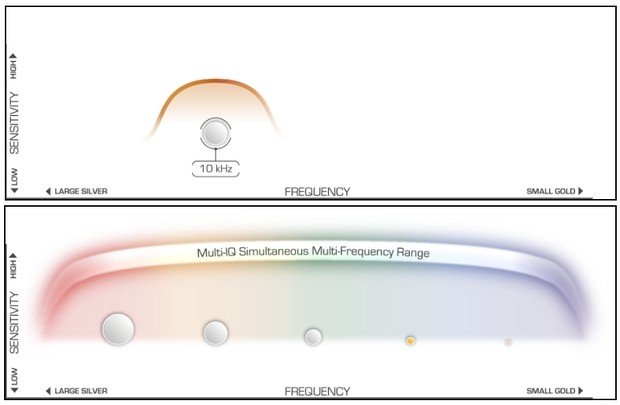
According to Philip Wahrlich, “From our testing, the Multi-IQ deployed in EQUINOX detectors has shown no significant trade-offs relative to the best single-frequency detectors and exceeded performance benchmarks in many important attributes, especially discrimination. And, for good measure, EQUINOX can also be operated as a single-frequency detector”
While we could delve into this aspect further, many of our readers are likely more interested in what happens within the white Multi-IQ band itself, rather than single versus multi. What has Minelab developed new, and uniquely, with frequencies to give better performance across the whole range of targets for different conditions?
The Multi-IQ transmit signal used in EQUINOX is a complex waveform where multiple frequencies are combined in a very dissimilar way than our proven BBS/FBS technology in Excalibur II / Safari / E-TRAC / CTX 3030 detectors.
If you view the BBS signal amplitude on an oscilloscope, it looks something like this:
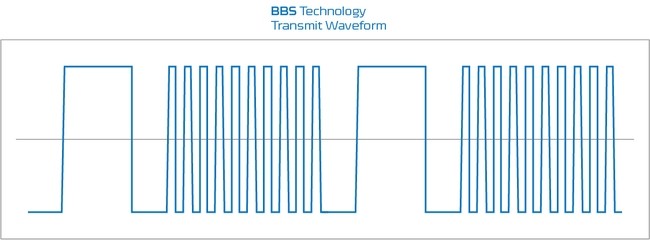
In comparison, Multi-IQ looks something like this:
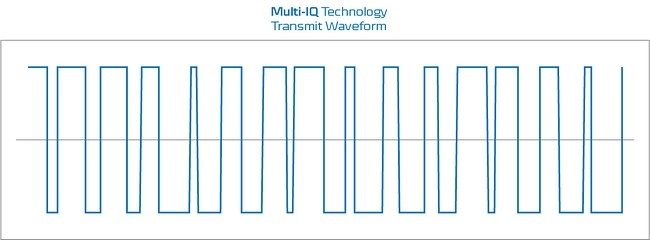
Hence – Multi-IQ is not a derivative or evolution of BBS/FBS. Multi-IQ is a DIFFERENT method of simultaneous multi-frequency metal detection. We could also debate “simultaneous” versus “sequential” semantics; however the real detection ‘magic’ doesn’t happen with what is transmitted to and received from the coil alone. Remember, in Part 2, we discussed how frequencies are “combined AND processed” as being important for achieving better results?
Let’s assess Multi-IQ for the different Detect Mode search profiles:
- Park 1 and Field 1 process a lower weighted frequency combination, as well as using algorithms that maximise ground balancing for soil, to achieve the best signal to noise ratio. Hence being most suited for general detecting, coin hunting, etc.
- Park 2 and Field 2 process a higher weighted combination of the Multi-IQ band while still ground balancing for soil. Therefore they will be more sensitive to higher frequency (low conductive) targets, but potentially more susceptible to ground noise.
- Beach 1 also processes a lower weighted combination, BUT uses different algorithms to maximise ground balancing for salt. Hence being most suited for both dry and wet sand conditions.
- Beach 2 processes a very low weighted frequency combination, using the same algorithms as Beach 1 to maximise ground balancing for salt. This search profile is designed for use in the surf and underwater.
- Gold 1 and Gold 2 process the higher weighted combination of the Multi-IQ band while still ground balancing for soil. However, they use different setting parameters better suited for gold nugget hunting.
Earlier we discussed the different Multi-IQ “frequency weightings” for the different search profiles. Now let's explain further why it is not a simple matter of just referring to specific individual frequencies for learning more about Multi-IQ technology. Let’s now consider one of the key practical detecting outcomes and then discuss how this was achieved…
“A lot of people are going to be surprised at how well the machine works in saltwater. At the outset we weren’t sure whether reliably detecting micro-jewelry in a conductive medium was even possible, but – with the help of our field testers and the subsequent fine-tuning of the Multi-IQ algorithms – we’ve found the EQUINOX to be more than capable.” Dr Philip Wahrlich
Background and considerations
While Multi-IQ may appear as ‘magic’ to some, to our team of signal processing experts, it’s the result of a significant number of man-years of development. So where did they start? By assessing the metal detectors and technologies available in the market at that time, along with typical customer perceptions about their practical applications; and actual detecting results achieved:

So, an important goal with developing Multi-IQ technology was to retain the above simultaneous multi-frequency advantages AND greatly improve performance in the two key areas where many single-frequency detectors typically excel – fast recovery in iron trash and finding low conductors in all conditions.
Speeding up the process
Most comparable low-power Continuous Wave transmit-receive detectors (for the same coil size) will have a similar raw detection depth at which the transmit signal penetrates the ground and has the potential to energize a target. To increase detection depth significantly typically requires higher power and Pulse Induction technology. This has advantages for gold prospecting, but discrimination is poor for identifying non-ferrous targets. While we continue to push for depth improvements, Multi-IQ also aims to provide substantial speed improvements, resulting in being able to better find ALL non-ferrous targets among trash in ALL locations. You could therefore say “fast is the new deep, when it comes to EQUINOX!”
Let’s start with considering signal processing not as a ‘black box’ where ‘magic’ happens, but more as a complex chain of applied algorithms, where the goal is to more accurately distinguish very small good target signals from ground noise, EMI and iron trash. Now, ‘fast’ by itself is not enough – you can have fast with poor noise rejection and poor target identification, giving no great advantage. Fast is also not just a result of microprocessor speed. Processors operate at much higher speed than is needed to ‘do the signal processing math’.
You can think of the signal processing chain broadly as a set of filters and other processes which are applied to the metal detector signals to convert these signals into useable, informative indicators, such as an audio alert or a target ID. For Multi-IQ, keeping the ‘good’ properties of these filters, while keeping them lean and removing unnecessary processing, was an important step towards achieving ‘fast’ for EQUINOX.
It’s also important to recognize that these filters are not the coarse filters of the analogue electronics hardware of last century – it all happens in software these days. Perhaps think of the older analogue TV standards versus current digital TV. (Standard digital HDTV has approx.10 times the resolution of analogue NTSC.) With metal detectors, a fast higher resolution filter set will result in improved target recognition.

Factoring in the ground conditions
However, speed without accuracy is not enough to produce a “game changer” detector – and improved accuracy cannot be achieved with a single frequency alone. Why? – “multi-frequency has more data-points” Philip Beck, Engineering Manager. This is worth explaining in more detail…
All transmit-receive detectors produce in-phase (I) and quadrature (Q) signals that can be processed in various ways depending upon the response received from targets, ground and salt. This processing happens through ‘channels’ that have different sensitivities to the different signals received. It is important to recognize that channels are not exactly frequencies. This is why it is more complex to explain than just correlating optimum frequencies to specific target types.
With a single frequency detector there are two basic channels for information (i.e. I and Q) that respond differently to good and bad signals, depending upon the frequency of operation and whether you are looking the the I or Q signal. It is also possible to scale and subtract these signals, while taking ground balance into account, to best maximize good signals and minimize bad signals. You could thus think of single-frequency being Single-IQ, with a limited set of data (e.g. I, Q, I-Q, Q-I) that works well for a particular set of conditions. To further enhance performance for a different set of conditions, you need to change frequency and detect over the same ground again. Therefore a selectable single frequency detector has an advantage with more data available, but not all at once (e.g. I1, Q1, I1-Q1, Q1-I1 OR I2, Q2, I2-Q2, Q2-I2 for as many frequencies that you can select from).
Now, getting back to Philip Beck’s “more data-points”, and just looking at two frequencies, a simultaneous multi-frequency detector would be able to process (for example) I1, Q1, I1-Q1, Q1-I1 AND I2, Q2, I2-Q2, Q2-I2 AND I1-Q2, Q2-I1, I2-Q1, Q1-I2 to give better detection results. Increase the number of frequencies further and the number of extra data-points also increases accordingly. What Multi-IQ does is process different optimized channels of information (not just individual frequencies) for the different modes. We have previously explained this as “frequency weighting” (in Part 3), where the various EQUINOX Search Profiles are matched to the respective ground conditions and target types.
Here is a very simplified example where you can see the result of processing more than a single channel of information (remember, a channel is not a frequency):
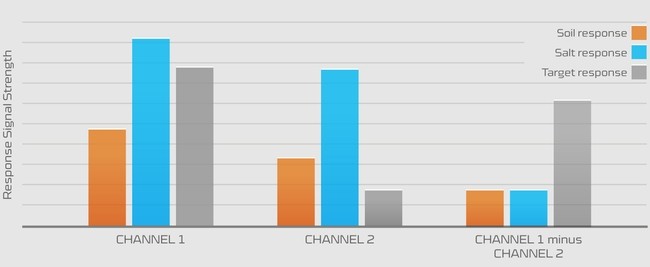
Channel 1 has a strong target signal, but the salt signal is stronger still. Channel 2 has weaker signals for soil, salt and the target. If the detector just responded to either Channel 1 or Channel 2, the target would not be heard through the ground noise. If the detector processes a subtraction of the channels (e.g. ch.1-ch.2), then it is possible to ignore the ground noise and extract a strong target signal. Now, think back to the high number of possible combinations of I and Q for simultaneous multi-frequency compared to single-frequency and the frequency weightings for the modes. All of the EQUINOX Park, Field, Beach and Gold Search Profiles have dedicated signal processing to best suit the conditions and types of targets being searched for.
Conclusion
Multi-IQ = more data-points = sophisticated processing = better ground noise rejection = more finds
Just as targets are more sensitive to certain frequencies, so is the ground – an important reason why air testing has inherent limitations when comparing detector performance. As soon as you have ground to consider in the signal processing equation, it can greatly impact on the ability of a single-frequency detector to accurately identify a target. Also, the deeper a target is buried, the weaker the target signal is, relative to the ground signal. The most difficult ground response to eliminate is the salt response, which varies greatly between soil, dry sand, wet sand and seawater. It is not possible to eliminate the salt response and the soil mineralization response (e.g. black sand) with just one frequency. However, within the carefully calibrated Multi-IQ channels, EQUINOX is able to identify both signals and therefore mostly ‘reject’ them (just as you would notch discriminate an unwanted target) BUT still detect gold micro-jewelry.
The above article is a compilation of a series of blog entries taken from Minelab's Treasure Talk. More will be added here as available.
-
 14
14
-
 1
1


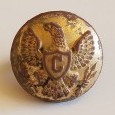
.thumb.jpg.435de4e259f1796cbed6ec8711efa9c5.jpg)


.thumb.jpg.d71314a45f3dc82bf75ac1b96e7e9201.jpg)